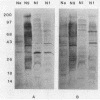Abstract
Serum samples from adult humans in North Carolina and Pennsylvania were assayed for antibodies against four Naegleria species: N. australiensis, N. fowleri, N. gruberi, and N. lovaniensis. Agglutinating activities of serum samples from North Carolina subjects were higher for N. fowleri than were those from Pennsylvania subjects. The distributions of agglutination titers of human serum samples for N. australiensis, N. gruberi, and N. lovaniensis were heterogeneous. The agglutination capabilities of selected serum samples absorbed with rounded, killed trophozoites of N. australiensis and N. lovaniensis were distinctly different, as were those of serum samples absorbed with N. fowleri and N. gruberi. N. australiensis and N. gruberi shared some agglutinating antigens, as did N. fowleri and N. lovaniensis. The agglutinating activities of most serum samples correlated with the capability of their immunoglobulin M (IgM) to bind to antigens in extracts of Naegleria species but not with the capabilities of their IgG to bind to antigens of Naegleria species. Absorption of IgM binding capability with rounded, killed trophozoites established that N. gruberi was distinctly different from N. fowleri and N. lovaniensis but that N. fowleri and N. lovaniensis shared surface antigens. The proteins in extracts of the four Naegleria species were subjected to sodium dodecyl sulfate-polyacrylamide gel electrophoresis (SDS-PAGE) and tested for their ability to bind immunoglobulins in a serum sample. The antigens of the four species that bound IgM or IgG in the tested serum sample were separated by SDS-PAGE, and when they were incubated with anti-IgM or anti-IgG, they gave distinct profiles. There was one distinct, shared antigen that had a molecular size of 40,000 daltons. Absorption of the test serum with killed, rounded trophozoites did not markedly change the immunoglobulin binding profile for Naegleria internal antigens separated by SDS-PAGE and did not remove the shared 40,000-dalton protein(s). These results demonstrate that the four Naegleria species have antigenically distinct surfaces and that humans have been individually exposed to antigens of Naegleria species.
Full text
PDF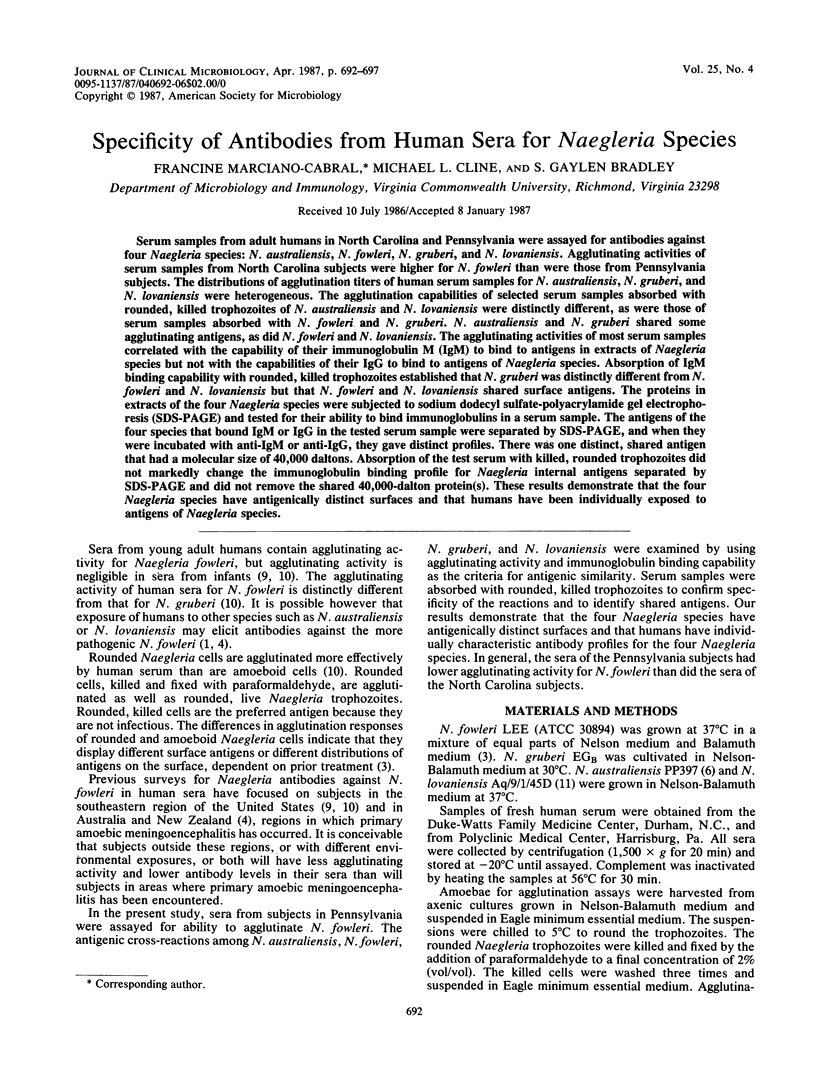

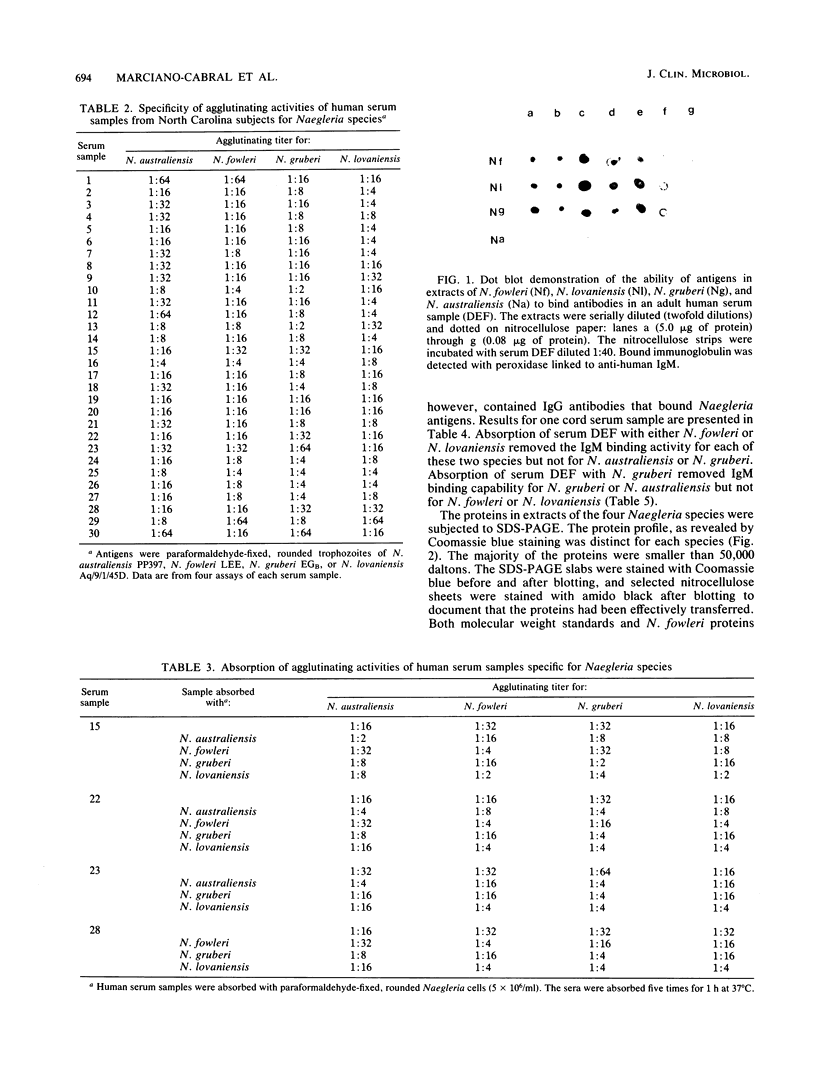
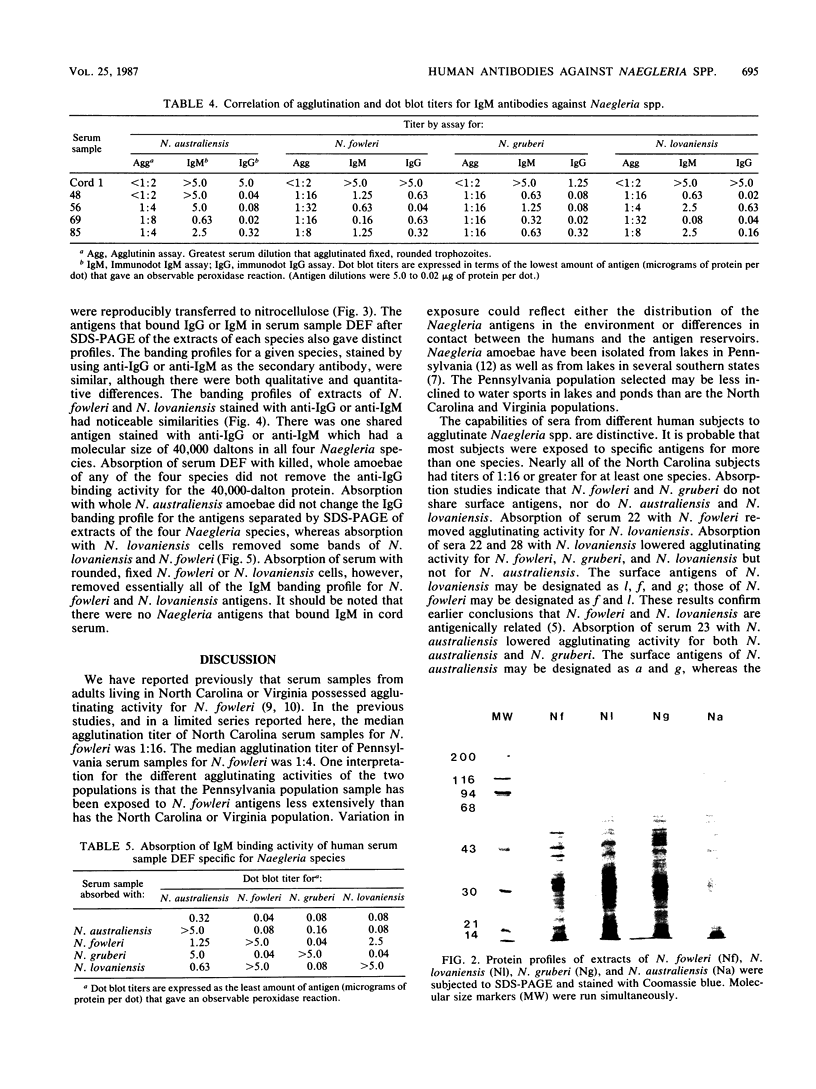
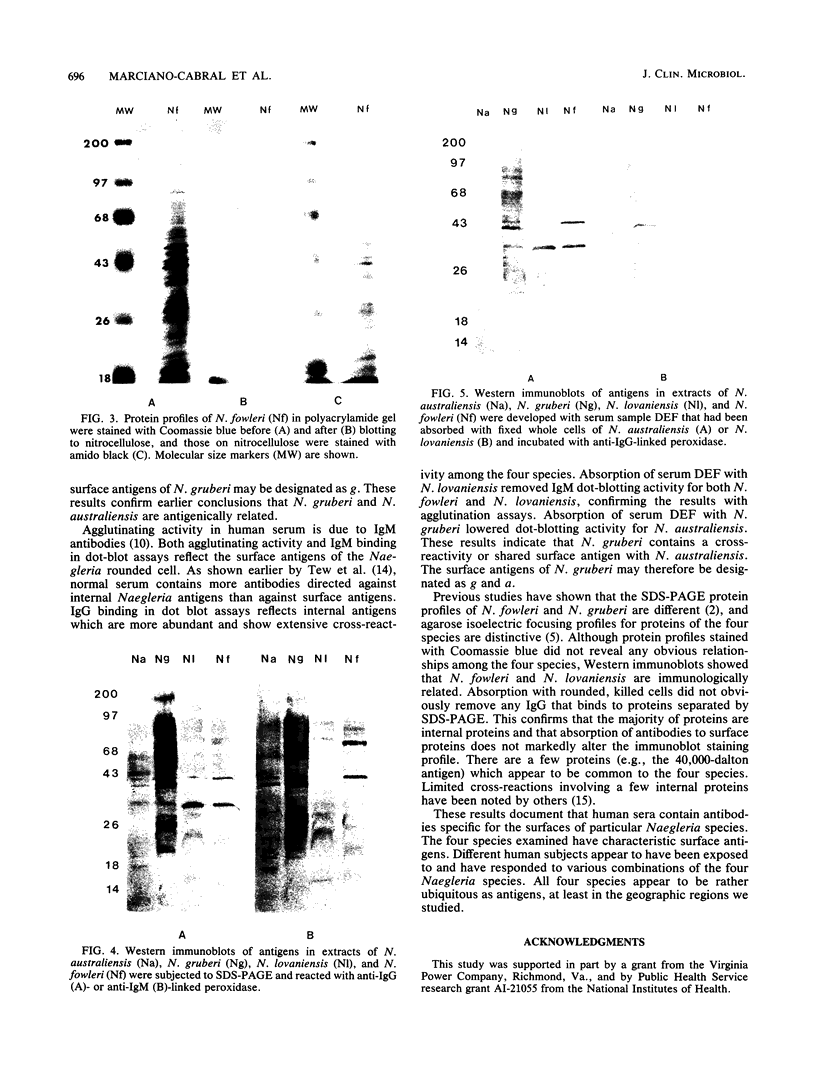
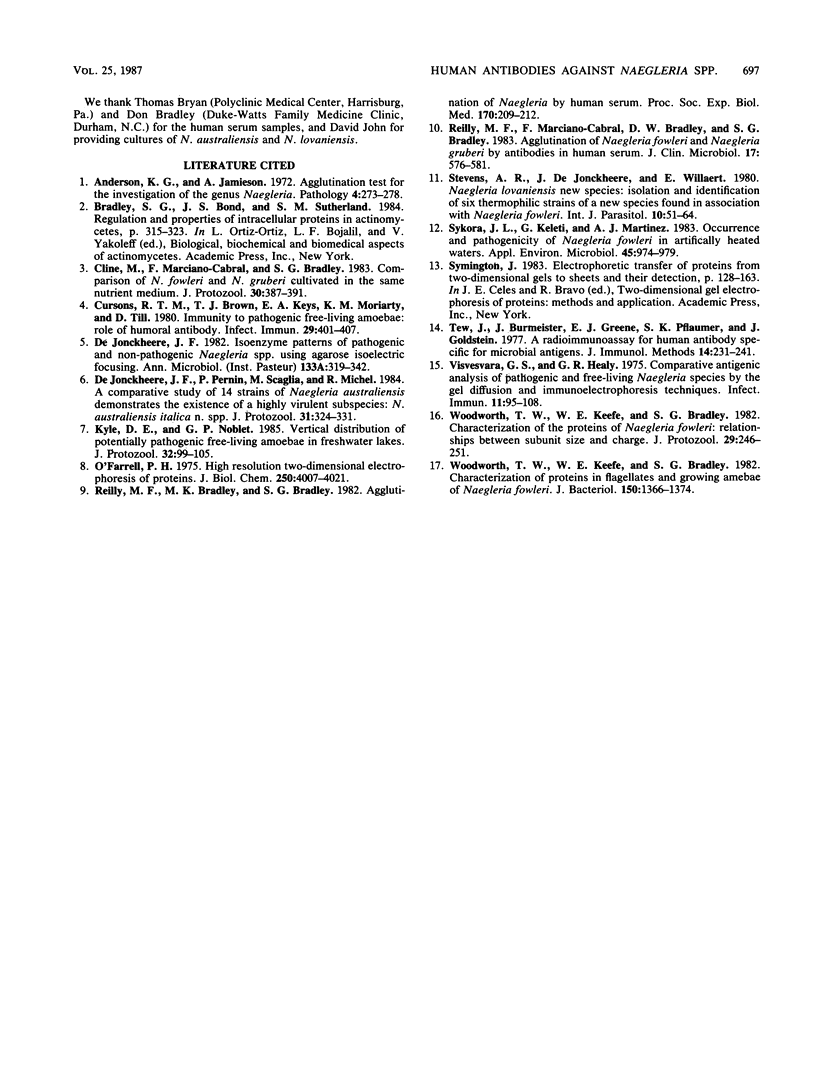
Images in this article
Selected References
These references are in PubMed. This may not be the complete list of references from this article.
- Anderson K., Jamieson A. Agglutination test for the investigation of the genus Naegleria. Pathology. 1972 Oct;4(4):273–278. doi: 10.3109/00313027209068953. [DOI] [PubMed] [Google Scholar]
- Cline M., Marciano-Cabral F., Bradley S. G. Comparison of Naegleria fowleri and Naegleria gruberi cultivated in the same nutrient medium. J Protozool. 1983 May;30(2):387–391. doi: 10.1111/j.1550-7408.1983.tb02936.x. [DOI] [PubMed] [Google Scholar]
- Cursons R. T., Brown T. J., Keys E. A., Moriarty K. M., Till D. Immunity to pathogenic free-living amoebae: role of humoral antibody. Infect Immun. 1980 Aug;29(2):401–407. doi: 10.1128/iai.29.2.401-407.1980. [DOI] [PMC free article] [PubMed] [Google Scholar]
- De Jonckheere J. F. Isoenzyme patterns of pathogenic and non-pathogenic Naegleria spp. using agarose isoelectric focusing. Ann Microbiol (Paris) 1982 Mar-Apr;133(2):319–342. [PubMed] [Google Scholar]
- De Jonckheere J. F., Pernin P., Scaglia M., Michel R. A comparative study of 14 strains of Naegleria australiensis demonstrates the existence of a highly virulent subspecies: N. australiensis italica n. spp. J Protozool. 1984 May;31(2):324–331. doi: 10.1111/j.1550-7408.1984.tb02971.x. [DOI] [PubMed] [Google Scholar]
- Kyle D. E., Noblet G. P. Vertical distribution of potentially pathogenic free-living amoebae in freshwater lakes. J Protozool. 1985 Feb;32(1):99–105. doi: 10.1111/j.1550-7408.1985.tb03022.x. [DOI] [PubMed] [Google Scholar]
- O'Farrell P. H. High resolution two-dimensional electrophoresis of proteins. J Biol Chem. 1975 May 25;250(10):4007–4021. [PMC free article] [PubMed] [Google Scholar]
- Reilly M. F., Bradley M. K., Bradley S. G. Agglutination of Naegleria fowleri by human serum. Proc Soc Exp Biol Med. 1982 Jun;170(2):209–212. doi: 10.3181/00379727-170-41420. [DOI] [PubMed] [Google Scholar]
- Reilly M. F., Marciano-Cabral F., Bradley D. W., Bradley S. G. Agglutination of Naegleria fowleri and Naegleria gruberi by antibodies in human serum. J Clin Microbiol. 1983 Apr;17(4):576–581. doi: 10.1128/jcm.17.4.576-581.1983. [DOI] [PMC free article] [PubMed] [Google Scholar]
- Stevens A. R., De Jonckheere J., Willaert E. Naegleria lovaniensis new species: isolation and identification of six thermophilic strains of a new species found in association with Naegleria fowleri. Int J Parasitol. 1980 Feb;10(1):51–64. doi: 10.1016/0020-7519(80)90064-8. [DOI] [PubMed] [Google Scholar]
- Sykora J. L., Keleti G., Martinez A. J. Occurrence and pathogenicity of Naegleria fowleri in artificially heated waters. Appl Environ Microbiol. 1983 Mar;45(3):974–979. doi: 10.1128/aem.45.3.974-979.1983. [DOI] [PMC free article] [PubMed] [Google Scholar]
- Tew J. G., Burmeister J., Greene E. J., Pflaumer S. K., Goldstein J. A radioimmunoassay for human antibody specific for microbial antigens. J Immunol Methods. 1977;14(3-4):231–241. doi: 10.1016/0022-1759(77)90133-8. [DOI] [PubMed] [Google Scholar]
- Visvesvara G. S., Healy G. R. Comparative antigenic analysis of pathogenic and free-living Naegleria species by the gel diffusion and immunoelectrophoresis techniques. Infect Immun. 1975 Jan;11(1):95–108. doi: 10.1128/iai.11.1.95-108.1975. [DOI] [PMC free article] [PubMed] [Google Scholar]
- Woodworth T. W., Keefe W. E., Bradley S. G. Characterization of proteins in flagellates and growing amebae of Naegleria fowleri. J Bacteriol. 1982 Jun;150(3):1366–1374. doi: 10.1128/jb.150.3.1366-1374.1982. [DOI] [PMC free article] [PubMed] [Google Scholar]







